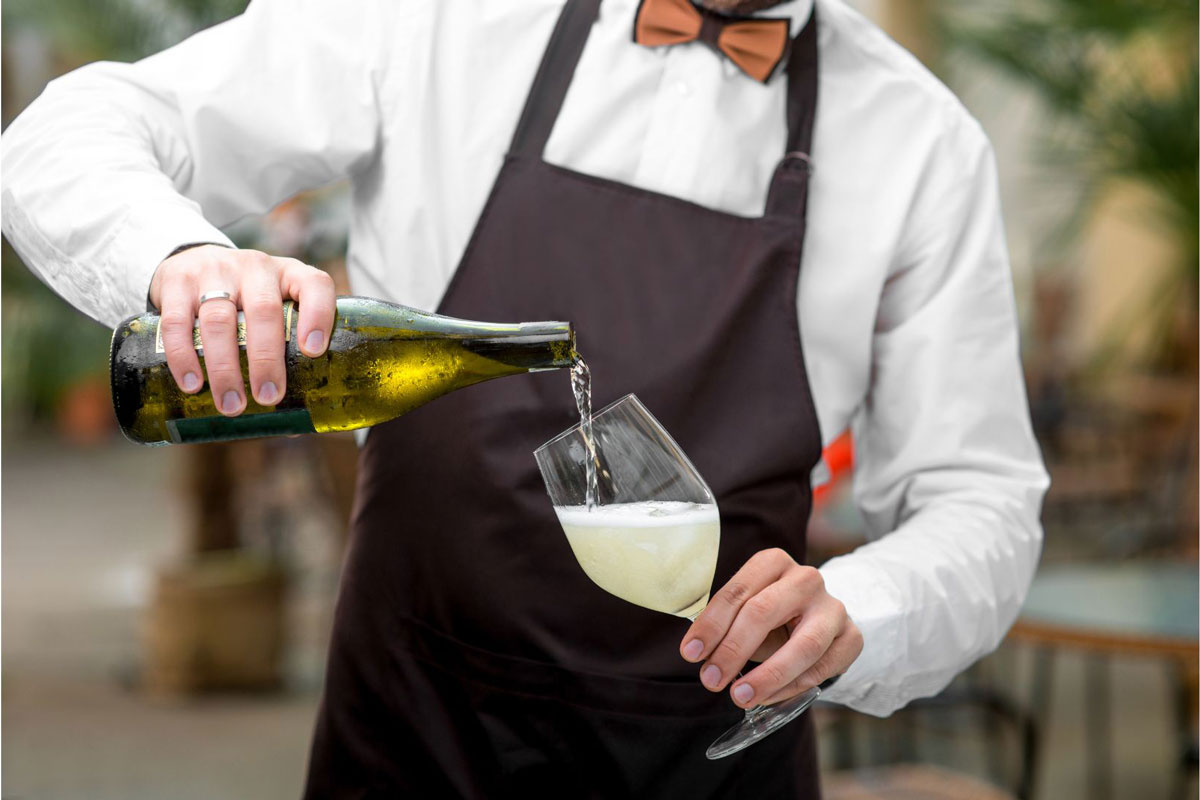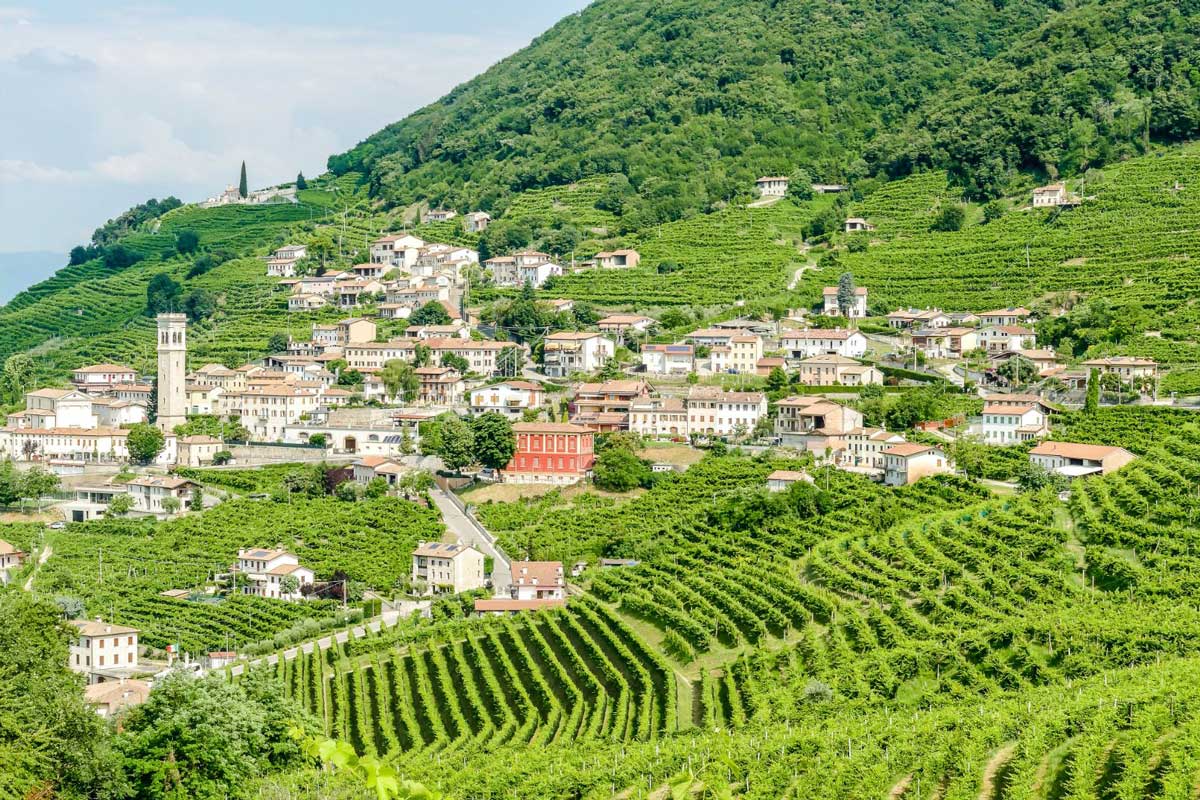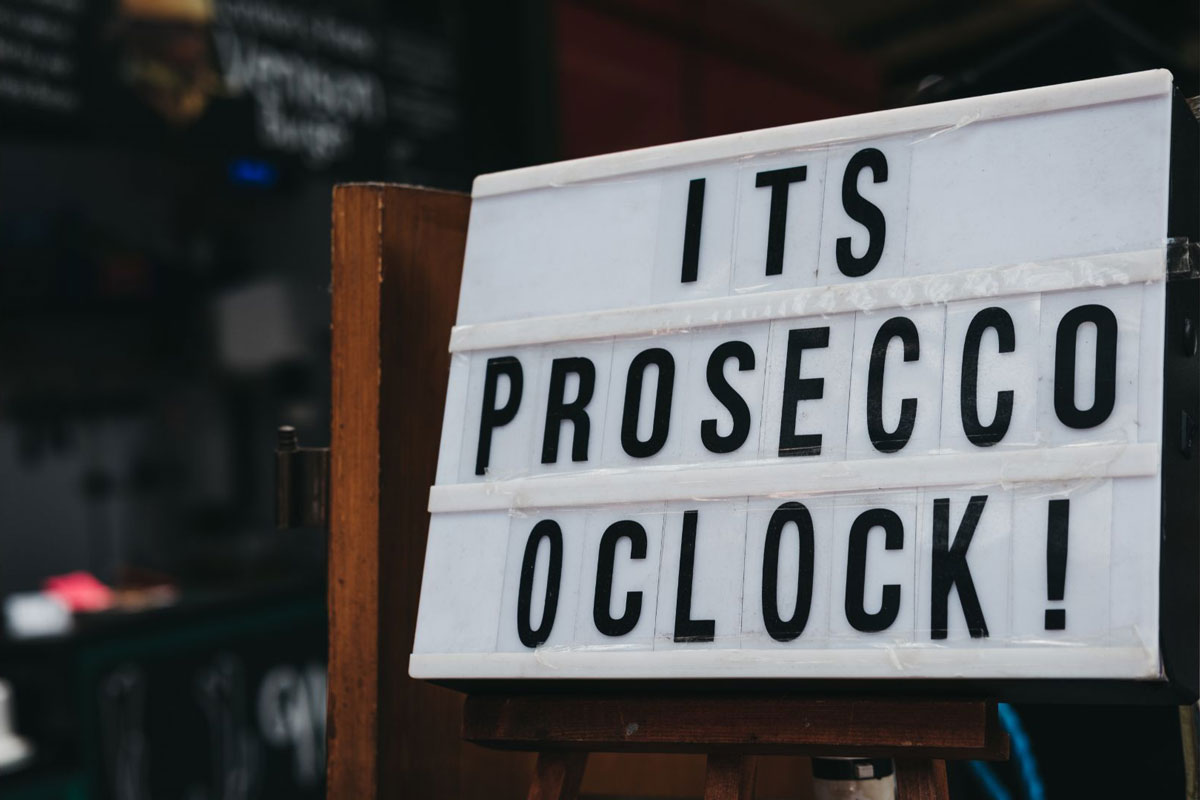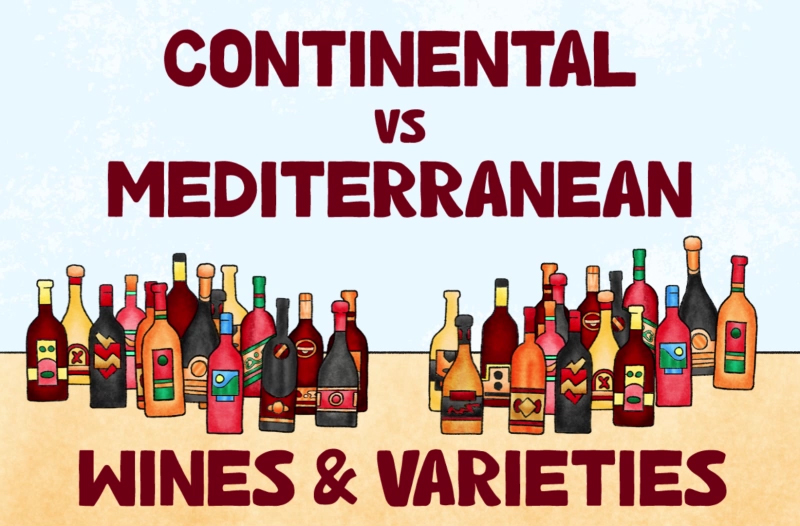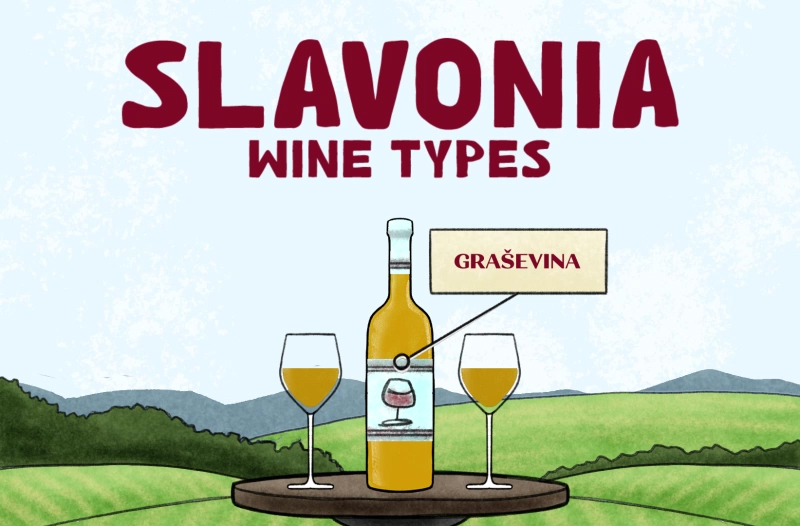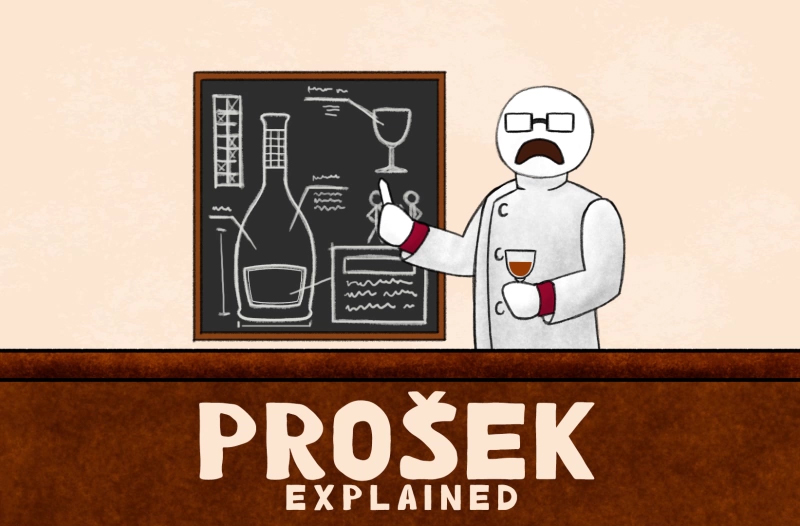Prosecco Method – How is Charmat Sparkling wine made?
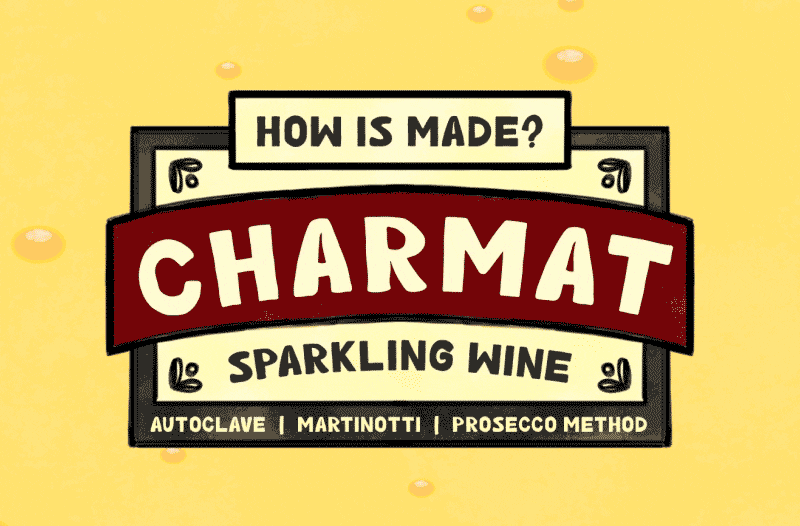
In this journey, we will unravel the intricacies of the Charmat method, the technique that gives Prosecco its distinctive character. From the sun-drenched vineyards of Veneto and Friuli regions to the delicate orchestration of fermentation and ageing, each step contributes to creating a sparkling wine that has captured hearts worldwide.
As we peer into the fascinating world of Prosecco production, we’ll try to demystify the artistry behind this celebrated Italian bubbly. There are careful stages that transform humble grapes into a symphony of taste and brilliance. Thanks to them, the Prosecco Charmat method has carved its own place in the pantheon of sparkling wine craftsmanship.
What is the Prosecco method of production?
The greatest difference between the Prosecco Method (Charmat Method) of producing sparkling wine and other methods used for both sparkling and still wines lies in how the bubbles are created and how they influence the final product’s taste, texture, and overall character.
Prosecco, made using the Charmat Method, is known for its bright and fruity flavours. The process preserves the natural aromas of the grape varieties used, such as Glera, making Prosecco notably aromatic and vibrant. This is a key characteristic that distinguishes Prosecco from many other sparkling wines.
Is Prosecco a wine or Champagne?
Prosecco and Champagne are both types of sparkling wines, but they come from different regions and are made using distinct methods, resulting in differences in flavour, style, and characteristics.
Prosecco is a sparkling wine from Italy’s Veneto and Friuli regions. It is primarily made from the Glera grape variety and is produced using the Charmat Method (also known as the Martinotti Method). This method involves conducting the second fermentation (which creates the bubbles) in large pressurised tanks, resulting in a wine with bright fruit flavours, floral aromatics, and a lighter, fresher profile. Prosecco is known for its approachability, often enjoyed as an aperitif or in casual settings.
Champagne, on the other hand, is a specific type of sparkling wine that comes exclusively from the Champagne region of France. It is made using the Traditional Method (Méthode Traditionnelle or Méthode Champenoise). In this method, the second fermentation occurs in individual bottles, creating fine and persistent bubbles. Champagne tends to have more complex flavours, a creamy mouthfeel, and the potential for ageing. It is often associated with elegance, celebrations, and special occasions.
In summary, while both Prosecco and Champagne are sparkling wines, they have distinct origins, production methods, and flavour profiles. Prosecco is Italian and produced using the Charmat Method, resulting in a fresher and fruitier style, while Champagne is French and made using the Traditional Method, offering a more complex and refined character.
What is the difference between the Champagne and Prosecco method?
The primary difference lies in where and how the second fermentation occurs. Here’s a simple explanation of the main differences between the Champagne method and the Prosecco method of making sparkling wine:
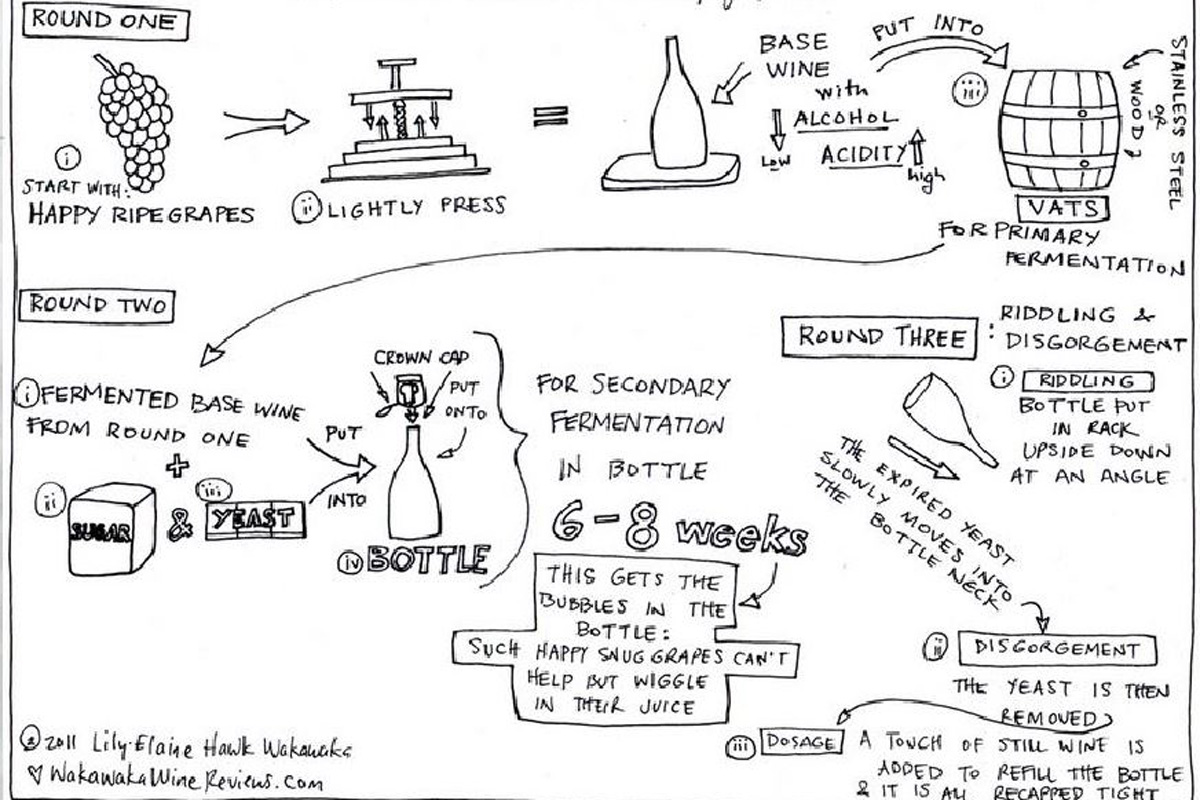
Champagne Method (Méthode Traditionnelle or Méthode Champenoise)
- Second Fermentation
In the Champagne method, the second fermentation, which creates the bubbles, takes place in individual bottles. Each bottle is sealed with a crown cap.
- Ageing on Lees
The wine undergoes an ageing period on the spent yeast cells (lees) in the bottle. This process contributes to a creamy texture and complex flavours.
- Riddling and Disgorgement
After aging, the bottles are gently rotated and gradually tilted to allow the yeast sediment to move toward the bottle neck. The sediment is then removed through a process called disgorgement, and a small amount of sugar (dosage) is added before sealing the final cork.
- Fine Bubble
The Champagne method generally produces finer and more persistent bubbles due to the longer ageing and fermentation in the bottle.
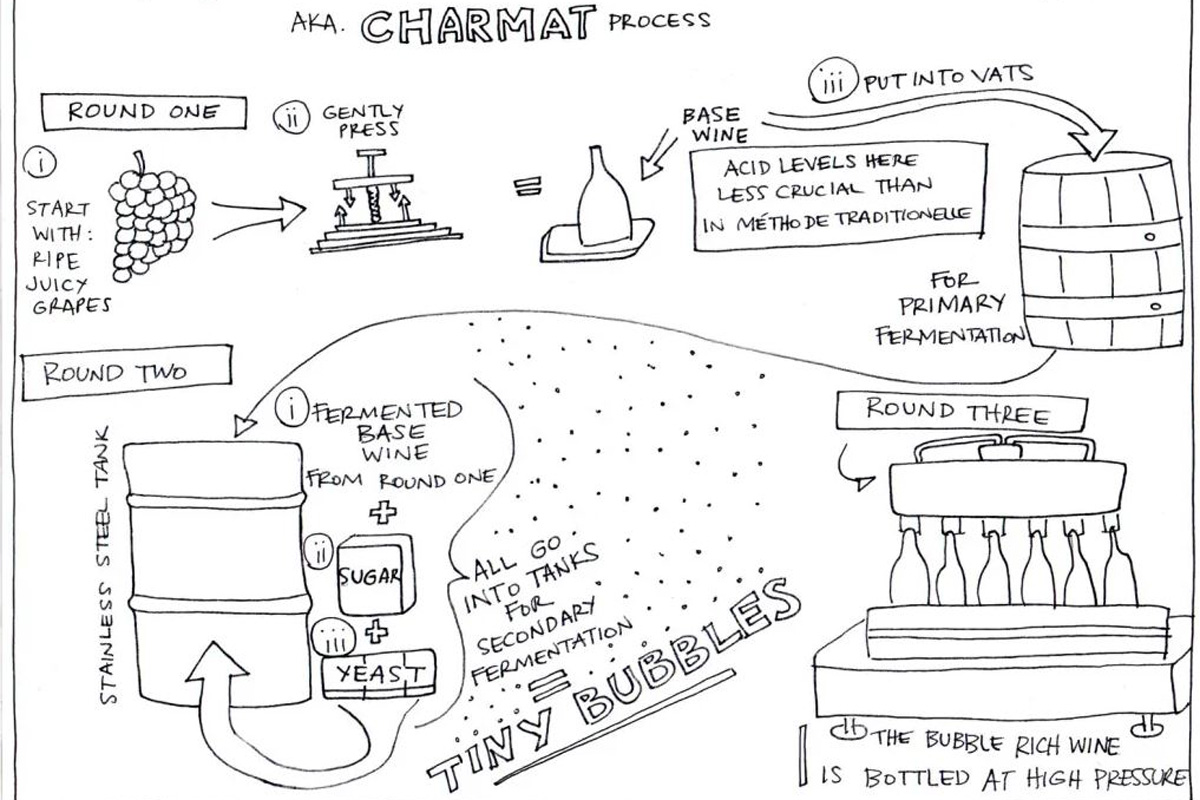
Prosecco Method (Charmat Method or Martinotti Method)
- Second Fermentation
In the Prosecco method, the second fermentation happens in large pressurised tanks rather than individual bottles.
- Shorter Ageing
The ageing period is typically shorter than in the Champagne method, resulting in a fresher and fruitier character.
- Fruit-Forward
The method emphasises preserving the fruity and floral aromas of the grapes, resulting in a wine with a light and vibrant profile.
- Ease of Production
The Prosecco method allows for a more efficient and cost-effective production process than the Champagne method.
Why is Prosecco made with the tank method?
The Charmat Method is favoured for Prosecco production because it preserves the wine’s vibrant fruitiness and floral aromatics. It also allows for a relatively quick production process, making Prosecco an accessible and enjoyable sparkling wine for various occasions.
The following are the most important reasons for choosing the Charmat method:
- Bubbles and Effervescence – results in smaller, delicate bubbles that contribute to a lighter and fresher mouthfeel than most of the wines produced using other methods.
- Refreshing Younger Profile – The Charmat Method typically results in wines that are meant to be enjoyed relatively young. Prosecco is often released shortly after production, offering a youthful and refreshing taste.
- Less Production Time – Charmat method makes Prosecco more accessible and often more affordable, which contributes to its popularity.
- Texture and Mouthfeel – Charmat-made sparkling wines tend to have a softer and lighter texture, making them a versatile choice for various occasions.
Does Prosecco use the traditional method?
No, Prosecco does not use the traditional method (Méthode Traditionnelle or Méthode Champenoise) for its production. The traditional method involves conducting the second fermentation, creating bubbles inside individual bottles. This method is commonly used for Champagne and other high-quality sparkling wines inspired by Méthode Champenoise.
Prosecco is primarily made using the Charmat Method (also known as the Martinotti Method). In this method, the second fermentation occurs in large pressurised tanks rather than individual bottles. This approach allows for a more efficient and cost-effective production process while emphasising preserving the wine’s primary fruity and floral qualities.
The Charmat Method is a defining characteristic of Prosecco production and contributes to the wine’s distinct flavour profile, lightness, and approachability.
What is Col Fondo Prosecco?
However, before the introduction of technology that made modern-day Prosecco possible, specifically the large Autoclave tanks suitable for high-pressure fermentation, there was a traditional and somewhat rustic style of Prosecco made using an ancient technique – “Col Fondo” or “Colfòndo” Prosecco.
The term “Colfondo” translates to “with sediment” in Italian, and this style of Prosecco is known for its cloudy appearance due to the presence of natural yeast sediment in the bottle.
Colfondo Prosecco is made using the ancestral method, which is one of the oldest ways of producing sparkling wine. Here’s how it’s typically made:
- Grape Harvesting and Pressing: Grapes are harvested and gently pressed to extract the juice.
- First Fermentation: The juice undergoes the initial fermentation, converting sugars into alcohol to create a still base wine.
- Bottling: The partially fermented wine is bottled with some residual sugar and natural yeast. Unlike the Charmat Method Prosecco, which is filtered to remove sediment before bottling, Colfondo Prosecco is bottled with the sediment still present.
- Second Fermentation in Bottle: The bottles are sealed with crown caps and stored horizontally to allow the second fermentation to occur. During this fermentation, carbon dioxide is produced by the remaining yeast, creating natural bubbles.
- Ageing on Lees: After the second fermentation is complete, the wine ages on the lees (sediment) in the bottle. This extended contact with the lees contributes to the wine’s distinctive flavours, texture, and complexity.
- Racking and Disgorgement (Optional): Some Colfondo Prosecco producers choose to disgorge the sediment by carefully upending the bottles to allow the sediment to settle in the neck. The neck is then frozen, and the sediment is expelled when the crown cap is removed. This step is optional and may vary among producers. It is not consistent with mimicking the ancient technique.
- Finishing: The wine may or may not receive a small dosage (addition of sugar or wine) before the final cork is inserted.
This style of Prosecco has gained popularity among enthusiasts seeking traditional and unique expressions of the wine, offering a glimpse into the historical roots of Prosecco production. There are many variations from described practice, and one of the growingly popular today is the one without second fermentation taking place. Imagine an unfinished wine still undergoing primary fermentation put into the bottle before fermentation ends.
Where does Prosecco wine come from?
Prosecco wine originates from the northeastern regions of Italy, primarily the Veneto and Friuli Venezia Giulia regions. These regions are situated in the northern part of the country, bordering Slovenia and the Adriatic Sea.
The heartland of Prosecco production is within the Veneto region, specifically in the areas of Conegliano, Valdobbiadene, and Asolo, which are renowned for their high-quality Prosecco wines.
Picturesque landscapes of rolling hills, vineyards, and charming villages characterise the Prosecco production area. This region’s climate, soil types, and topography contribute to the unique characteristics of Prosecco grapes and the resulting wines.
Prosecco production has gained global recognition and popularity, making it one of Italy’s most renowned and exported sparkling wines.
The term “Prosecco” is protected by various appellations of origin, such as DOC (Denominazione di Origine Controllata) and DOCG (Denominazione di Origine Controllata e Garantita), which ensure that wines labelled as Prosecco adhere to specific quality and production standards.
Can Prosecco be made anywhere in the world?
No, Prosecco cannot be made anywhere in the world. The term “Prosecco” is protected by a designation of origin. It refers specifically to wines produced in certain designated regions in northeastern Italy, primarily the Veneto and Friuli Venezia Giulia regions.
The European Union’s regulations have established the geographical boundaries and production standards for Prosecco wines. These regulations protect the authenticity and quality of Prosecco by ensuring that wines labelled as Prosecco are made from specific grape varieties (primarily Glera) and adhere to production methods defined by the region.
Prosecco wines produced outside these designated regions cannot legally use “Prosecco.” However, similar sparkling wines made using different grape varieties and production methods may exist in other parts of the world.
In summary, Prosecco is a specific type of sparkling wine with geographical indications that limit its production to designated areas in Italy. Wines produced outside these regions cannot be labelled as “Prosecco.”
Of course, any winery owning an autoclave tank can make a Charmat method sparkling wine. There are many examples of such wines around the world.
For example, many Croatian Malvasia producers from Istria send their wine to Prosecco producers to make a Charmat method sparkling Malvasia Istriana.
Some wineries, such as Enosophia, use their own autoclave tanks to make sparkling wines using the Charmat method.
These wines cannot be labelled as Prosecco but can rival many Prosecco wines in their style and affordability.
Why is Prosecco cheap?
There are two main reasons why Prosecco is considered “cheap” or more affordable than other types of sparkling wines, such as Champagne: Production Method and Scale of Production.
The production method known as Charmat, or Martinotti, is generally more cost-effective and efficient than the labour-intensive Champagne method.
Prosecco is produced in large quantities, which leads to economies of scale that help reduce production costs.
There are other reasons why Prosecco is considered “cheap” in comparison. For example:
- Less labour cost because making Prosecco have fewer manual steps
- Less ageing time is required because Prosecco is meant to be enjoyed when young
- The lower price of the grapes, compared to Champagne, for example, and also, the yields are normally less restrictive because Prosecco rarely require concentration
As it is with everything, there are notable exceptions, and certain Prosecco wines from particular positions (Cartizze, Rive, Asolo) could achieve higher prices due to the limited availability and quality of the grapes.
Is Prosecco stronger than wine?
Prosecco is a type of wine, specifically a sparkling wine, and its alcohol content is generally similar to that of other wines.
The alcohol content of Prosecco, like all wines, can vary depending on the specific producer and style, but it typically ranges from around 11% to 12.5% alcohol by volume (ABV). This is similar to the alcohol content of many still wines, such as white wines or red wines.
It’s worth noting that the perception of strength in wine can also be influenced by factors such as the balance of flavours, sweetness, acidity, and effervescence. While Prosecco is a sparkling wine with bubbles, its alcohol content is within the typical range for wines, and it is not inherently stronger than other wines.
Therefore, the alcohol content is not something of an issue with Prosecco and many other Charmat method wines. What could be a warning sign for many is the drinkability of Prosecco. It’s both a chilled thirst-quencher and easy-drinking wine, making it succulent sip after sip and thus dangerous for intoxication without noticing.
Charmat method wines
There are a multitude of Charmat-made wines around the world. Unlike Prosecco, which is obliged to vinify only Glera (with a couple of exceptions in certain DOC), other wineries from other regions can pretty much vinify any available variety.
This makes the world of Prosecco-style wines much more interesting. Because despite having a lot of diversity even within somewhat strict boundaries of protected Prosecco wines, there is a whole world of sparkling wines made under the Charmat method, but with different results.
Some achieve the ideal balance of a good Prosecco. Others introduce certain varieties to the bubbles for the first time. In short, the Charmat method created versatility and the ability to experiment with different varieties and different styles, making the wine world richer.
Charmat method wines of Croatia
The first winery that brought the autoclave tanks to Croatia is Enosophia.
It was far from enough to cause shaking of the expanding Prosecco market in Croatia, but it was invigorating to witness the lively bubbles of vinified local varieties, such as Graševina or even Frankovka.
Following are the three styles of Charmat method sparkling wine made in Croatia:
- Nice To See You from Enosophia is, more traditionally, a blend of Chardonnay and Pinot Noir. Fast-pressed, sedimented, separate fermentation of varieties in duration of 12 hours at 16 °C. keeping at fine yeast sediment for 3 months with stirring. Followed by repeated inoculation of yeast for the start of secondary fermentation in autoclave tanks. Fermentation lasts for 14 days. After that, autolysis of yeast for 5 months. Followed by filtration and preparation for bottling.
The result is fluttering, unobtrusive fresh aroma of mild fruit with distinctive sour cherry and a hint of yeasty notes. To be served ideally at 6-8 °C (43-46℉) in a sparkling wine glass or common glass for white wines.
- Today Blanc is 100% Graševina. Harvested when acidity is higher and sugar lower. After pressing, fermentation lasts a maximum of 14 days at 16 °C. After fermentation, wine is preserved in fine yeast sediment with stirring once to twice a week. After that period, secondary fermentation starts in Autoclave tanks. Fermentation also lasts for a maximum of 14 days at 16 °C. Autolysis (yeast extinction) occurs for a month and a half when fermentation finishes.
It’s a perfect welcome wine, emphasising citrus fruitness and freshness with a touch of floral.
- Even more interesting, Today Rose is made from Frankovka (Blaufrankisch) grape. After primary fermentation of base wine at 16 °C, secondary fermentation was started in autoclave tanks (lasting for 12 days ) with ageing on yeast for 2 months.
Sparkling Frankovka is an ideally balanced bubbly rose wine with a surprisingly persistent presence on the palate. Clarity and elegance in support of freshness.
What is also important and most welcomed by consumers is that these bubbles are hardly expensive compared to other sparkling wines.
This affordability, coupled with Charmat Method wines’ delightful and vibrant characteristics, allows enthusiasts to indulge in the joy of sparkling moments without breaking the bank. Whether enjoyed as a casual aperitif, a centrepiece of celebrations, or paired with a wide range of cuisines, Charmat Method wines offer an accessible and enjoyable avenue into the world of effervescent pleasures.
So, raise a glass, savour the effervescence, and let these wines’ charm add sparkle to life’s cherished moments.




